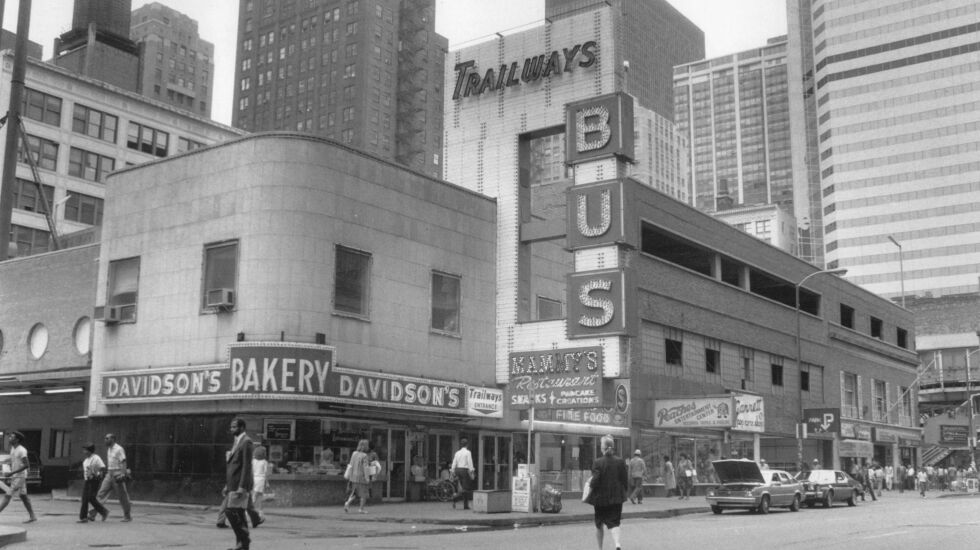
Cross-country bus terminals were once a part of almost every big-city downtown, as ever-present and important as tall buildings and department stores.
The Loop once had two: a Greyhound bus depot at Clark and Randolph streets, and a Trailways station at 20 E. Randolph St.
Both were iconic and modern buildings in their prime. But when the land beneath them became valuable — and bus stations were seen as too seedy and downmarket for downtown — both depots were razed in the late 1980s and their sites redeveloped.
Greyhound built a smart-looking new terminal at 630 W. Harrison St. in 1989, designed by a firm now known as Sheehan Nagle Hartray Architects.
But it appears Greyhound depot’s days are now numbered.
Twenty Lake Holdings, which last year bought the station and 33 others once owned by Greyhound, now wants to sell the property for residential redevelopment.
And how might passengers catch a bus or arrive downtown if there is no station?
“What we’re seeing around the country is, these stations close … and in numerous cases [bus service is] ending up occurring on the curb,” said DePaul University professor Joe Schwieterman, director of DePaul University’s Chaddick Institute for Metropolitan Development.
But a city with two major airports, and Union Station west of the Loop for Amtrak travelers, must have a facility for the 500,000 people who arrive here yearly by intercity bus.
If the Greyhound station is demolished and not replaced, Chicago would be the largest U.S. metropolis without an intercity bus terminal.
“That would be a real mess for a city as large as Chicago,” Schwieterman said.
Bus depots a vanishing breed
Urban bus depots were part of Americana, once. Not as much as old train stations or all-night diners, but close.

Drifters slipping into town by bus — in fiction, movies or real life — arriving under the cover of neon-accented darkness.
College students with backpacks and suitcases, heading back for the new semester as the hydraulic hiss of the bus’s closing door and the roar of its engine mingle with the sounds of downtown traffic.
That it all played out in the middle of downtown showed how central bus terminals once were to the city’s physical and cultural landscape.
How central? Architecture firm SOM’s original 1949 design for the Loop Greyhound station included an unbuilt skyscraper as modern and glassy — perhaps more so — as New York City’s landmark Lever House, completed in 1952.
Then 40 years later, the station was chased out of the Loop and put next to the Jane Byrne Interchange.
Now downtown’s expansion — much of it touched off around the time the old bus stations were demolished — has reached the Greyhound site.
And like that drifter arriving in town by bus, no one knows where a new terminal might turn up. If at all.
So what’s the solution?
Greyhound pays $1 million yearly under a lease with Twenty Lake Holdings that’s nearing its end.
“The best solution — and this is not without complexity — is a public agency acquires the station and makes it available to all intercity bus lines,” said Schwieterman, whose Chaddick Institute issued a study this month on the potential impact of the Greyhound station’s loss.
“Many cities are already doing that,” he said.
Ah, but which agency? Certainly not the CTA, which has its hands full just keeping L stations urine free.
And do we need another unit of government? Or could we broaden the MPEA’s authority to include a bus terminal at McCormick Place’s Lakeside Center? The Metropolitan Pier, Exposition and Bus Authority has a ring to it.
Fortunately, the Chicago Department of Transportation is working together with Greyhound.
The department said last week in a written statement to me: “The City of Chicago recognizes the importance of affordable and accessible intercity transportation and is actively assessing and exploring solutions to ensure Chicago continues to have an intercity bus terminal.”
That’s good. Now it’s up to Mayor-elect Brandon Johnson’s administration to make sure bus travelers aren’t kicked to the curb.
Lee Bey is the Chicago Sun-Times architecture critic and a member of the Editorial Board.
Send letters to letters@suntimes.com







